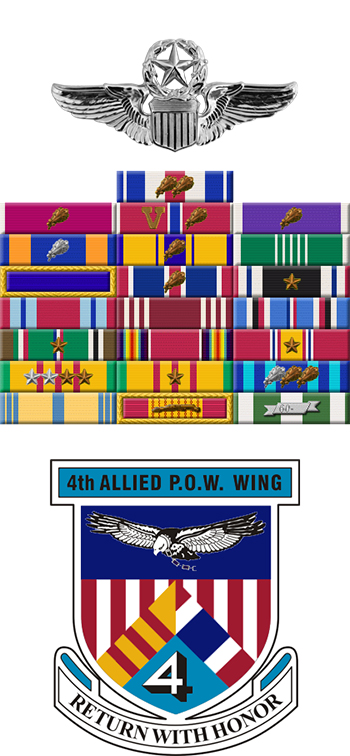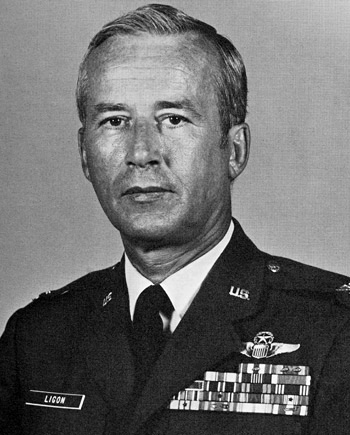
|
Vernon P. "Vern" Ligon, Jr. |
 |
|||
| Rank, Service | ||||
Colonel O-6, U.S. Air Force |
||||
| Veteran of: | ||||
|
||||
| Tribute: | ||||
Vern Ligon was born on the 4th of July 1921 in Frankfort, Kentucky. He enlisted in the Aviation Cadet program of the U.S. Army Air Forces on March 31, 1942, and was awarded his pilot wings and commission as a 2d Lt on May 20, 1943. He then attended P-47 Thunderbolt training at Westover Field, Massachusetts, followed by service as a P-47 pilot with the 377th Fighter Squadron of the 362nd Fighter Group at Bradley Field, Connecticut, from July to December 1943. Lt Ligon deployed with the 377th Fighter Squadron to England in January 1944, and transferred to the 379th Fighter Squadron, also in the 362nd Fighter Group in England, in March 1944. He was forced to bail out of his stricken aircraft over enemy lines on his 35th combat mission, and was taken as a Prisoner of War by the Germans on April 22, 1944. After spending 373 days in captivity, he was repatriated on April 29, 1945, and he returned to the United States in May 1945. After rest and recuperation, his next assignment was to Luke Field, Arizona, from August to October 1945, and then as a staff officer at Johnson Field, North Carolina, from November 1945 to July 1946. Capt Ligon attended Deck and Navigation School at Fort Eustis, Virginia, from July to November 1946, followed by service as a Deck Officer on crash boats at Fort Eustis from November 1946 to March 1947. He served as a Deck Officer and 2d Mate on crash boats at Seattle, Washington, from March 1947 to April 1948, and then as Master Deck Boat Officer on crash boats at Redbank, New Jersey, from April 1948 to December 1949. His next assignment was as a staff officer at Clark AB in Philippines from January 1950 to January 1952, and then as Commanding Officer and Petroleum Officer with the 6550th Support Squadron at Patrick AFB, Florida, from March 1952 to January 1956. Major Ligon attended B-47 Stratojet training from January to May 1956, and then served as a B-47 pilot with the 10th Bomb Squadron at Dyess AFB, Texas, from May 1956 to October 1958. His next assignment was as a B-47 pilot with the 491st Bomb Squadron at Dyess AFB from November 1958 to June 1961, followed by service as a B-47 pilot with the 427th Bomb Squadron at Davis-Monthan AFB, Arizona, from July to September 1961. Lt Col Ligon then transferred to the 360th Bomb Squadron at Davis-Monthan in September 1961, before serving as Chief of the Standardization Division with the 303rd Bomb Wing at Davis-Monthan from November 1961 to September 1962. He served as a Commander of the 360th Bomb Squadron at Davis-Monthan from September 1962 to August 1963, and then attended Air War College at Maxwell AFB, Alabama, from August 1963 to July 1964. His next assignment was as Chief of the Deployment Division at Patrick AFB, Florida, from July 1964 to May 1965, followed by service as Chief of the Range Control Division at Patrick AFB from June 1965 to February 1967. He then attended Tactical Reconnaissance Training and RF-4C Phantom II Combat Crew Training from February to August 1967, followed by service as an RF-4C pilot and Commander of the 11th Tactical Reconnaissance Squadron at Udorn Royal Thai AFB, Thailand, from September 1967 until he was forced to eject from his stricken aircraft while flying his 26th combat mission over North Vietnam and was taken as a Prisoner of War on November 19, 1967, becoming one of only two POWs in Vietnam to have been a POW twice. After spending 1,943 days in captivity, Col Ligon was released during Operation Homecoming on March 14, 1973. He was briefly hospitalized to recover from his injuries at Maxwell AFB, Alabama, and then served as Assistant to the Director of Range Operations at Patrick AFB, Florida, from July 1973 until his retirement from the Air Force on September 1, 1974. Vern Ligon died on February 28, 1995, and was buried at Florida Memorial Gardens in Rockledge, Florida. |
||||
|
||||

